| Title Proposal for Opening a New Branch Office In Texas or Georgia for ABC, Incorporated | |
|
Author Lindsay Schilling American River College, Geography 350: Data Acquisition in GIS; Spring 2004 | |
|
Abstract Purpose: To find the best location to establish a new branch office, within the state of Texas or Georgia, for ABC, Incorporated | |
|
Introduction ABC, Incorporated is an earth-work (grading) calculations/estimating company that offer other services such as GPS model-building, impact studies and photo-realistic renderings to surveyors, contractors, land developers, public planning agencies and architects. ABC, Inc. is currently looking to expand its business within the United States; specifically, they are scouting various areas to open a new branch office in the states of Texas or Georgia. It is my job to find the most productive location of substantial construction activity that will not only support the new branch office, but to assist ABC, Inc. in exceeding their income projections for the next eight to ten years. There are a number of issues, or criteria, to be examined: which of the two states is the fastest-growing, or most popular state based on population, how many building permits (and the types of permits) have been issued in the last few years within each state, and how these states treat new businesses in regards to corporate/business taxation. I will compare/contrast the states of Texas and Georgia using the above criteria in an effort to determine the best location for a new branch office. | |
|
Background It is important to examine many issues before opening an out-of-state business. In regards to ABC, Incorporated (primarily earth-work/grading calculators), the most important criteria would be to look at the number of building permits that have been issued within each state within the last few years. The key: the number of building permits in an area will attract the attention of ABC—potential work for earthmovers. I must regress a little to explain the attraction to building permits. A set of construction drawings must exist before a building permit is even issued. However, prior to the building permit being issued, earthwork (rough-terrain grading) must be done. Then, once the building permit is issued, precise earth grading is completed. Generally speaking, the larger the volume of building permits issued, the larger the volume of potential work for ABC, Incorporated. In order to find the most advantageous location for the new branch office, I needed information to jump-start my proposal; I interviewed the CFO of ABC, Incorporated. From that interview a simple, but important set of criteria was developed that would direct the focus of my proposal/project: a) Locating the fastest-growing/most popular cities within the United States since rapid population shifts are indicative of heavy construction activity. As the population increases, so do the demands for housing (single-family and multi-family dwellings), and other non-residential buildings (nonresidential/commercial building, schools, hospitals, roads, and so on). b) How many building permits are being issued within the states of Texas and Georgia. The number of issued permits (for single-family, multi-family and non-residential building/commercial) is of primary concern since it shows a flurry of construction activity and business for ABC, Inc. c) Corporate/Business taxation is always an issue when opening a business out-of-state. In this case it is not a crucial issue; if taxes are unusually high, or convoluted, in Texas or Georgia, ABC, Incorporated will avoid state business taxation by incorporating the new branch office in the state of Nevada where there are no income taxes. However, this is an issue that requires my attention so that ABC may proceed with prior knowledge of the taxation structure within each state. The bulk of my research and statistical information/charts were obtained from Internet sites. | |
|
Methods This project/proposal required extensive searches, research and printing from internet sites such as the adjusted 2002 U.S. Census Bureau statistics from “The Real Estate Center at Texas A & M University” (recenter.tamu.edu) for growth and shifts in population statistics and population projections, construction census, building permit statistics and types of dwelling permits; “Infoplease.com” for the “Top Ten Fastest-Growing Cities” and “Top Fifty Cities in the U.S. by Population and Rank”; local and state government websites for Texas and Georgia (“Do Business in Greater Austin”, www.austin-chamber.org, and “Texas and Georgia QuickFacts”, www.quickfacts. Census.gov) to obtain corporate income tax rates; and numerous city and state maps sites. At one point I had to change the focus of my project. It began as a study on the top ten fastest-growing cities, in order to establish a new branch office for ABC, Incorporated, within the United States. It was then ramped down to the top five fastest-growing cities. I ran into a serious problem here as well: too much information; my project/proposal was beginning to look like a dissertation. Again, I decided that I had to narrow the parameters of the project; I had discovered early on when accruing data that Texas and Georgia looked like the best locations regardless of the rest of the United States. I went back to the CFO of ABC, Incorporated and re-interviewed him. It seems that ABC, Incorporated had their eyes on Texas and Georgia all along; they had done their homework. After many hours of trying to pull together an overwhelming amount of information, I had finally redirected the focus of my project into a manageable task: to do a comparison/contrast between the two states. The CFO also indicated that their goal was to open one branch office within six to eight months; they want to know where and why; Texas versus Georgia. Texas was ultimately selected as one of the state’s of interest because of it’s current popularity with the U.S. population, the CFO’s interest and also due to the “Top 50 Cities in the U.S. by Population and Rank”, which indicated the state of Texas qualified with six (most popular) ranked cities in the U.S. These cities were ranked in order of numbers 4, 8, 9, 16, 23 and 27 (Infoplease.com). Hence, there is currently a large population shift in Texas requiring increased construction to accommodate growing population demands. Georgia was selected as one of the states because of the CFO’s interest, and again due to the “Top 50 Cities in the U.S. by Population and Rank” list that ranked Atlanta as number 39 out of 50 in the U.S. (Infoplease.com), and because Georgia’s neighboring states also have rising construction statistics (Georgia could be a centralized home base among these other states: North Carolina, South Carolina, Tennessee and Florida). The chart below indicates the ranked cities (out of the top fifty in the U.S.) for Texas and Georgia. It is important to note that all of the following charts are in thousands unless noted otherwise. |  |
The next important issue to be addressed is the actual population of Texas and Georgia and their population shift: each state’s population, their percent of change and their total population change from the previous year (the year 1992 is not included as I had to have a cut-off somewhere). Again, I extracted the years 1993-2002 which originally came from the adjusted 2002 U.S. Census Data via The Real Estate Center at Texas A & M University (recenter.tamu.edu). And, the next statistical chart, in thousands, addresses population projections for the years 1995-2025 (www.census.gov/population/ projections/state). I included the projections to show the population trends and to drive home the obvious: Texas rather than Georgia. The following charts are in thousands. | |
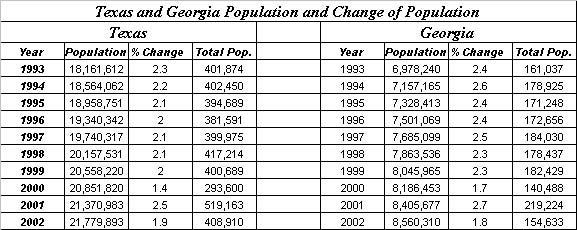 | |
 | |
Next I located suitable charts of building permits issued for single-family dwellings, 1993-2002; data for multi-family dwellings 1993–2002 (this data was ultimately extracted from the adjusted 2002 U.S. Census Data through the Real Estate Center at Texas A & M University [recenter.tamu.edu]); and, non-residential/commercial building 1986-1995 ([recenter.tamu.edu]. As this information is no longer being updated, I decided to only include the ten years of 1985-1995. I could not exclude this data since it may look as though I chose not to even examine nonresidential/commercial building permits. The following statistics addresses Single-Family Dwellings in Texas and Georgia for the years 1993 through 2002, the number of building permits issued for single-family units and the percent of change from the previous year (obviously the percent of change for 1992 is not included; I had to have a cut-off somewhere [recenter.tamu.edu]). | |
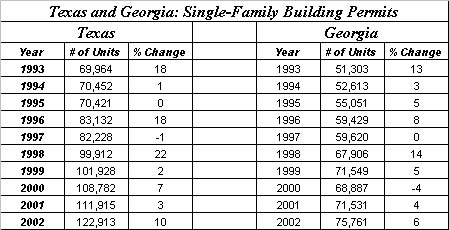 | |
The following statistics show the number of building permits issued for 2-4 family dwellings (this includes condominiums/apartments) by year, the number of building permits issued for these units and the percent of change from the previous year (again, 1992 is not included as indicated before [recenter.tamu.edu]). | |
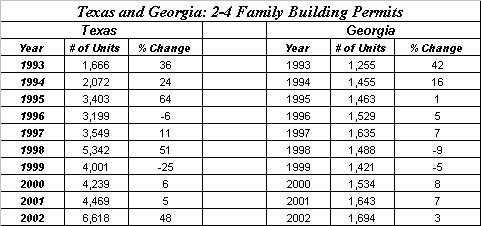 | |
The next figures are for building permits issued for multi-family dwellings of five or more (this typically includes large apartment buildings) by year, the number of building permits issued for these units and the percent of change from the previous year (recenter.tamu.edu). | |
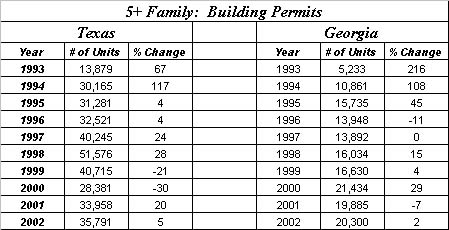 | |
And, finally, the following statistics are for building permits issued for nonresidential/ commercial building by year, the number of permits issued for each unit and the percent of change from the previous year (recenter.tamu.edu). | |
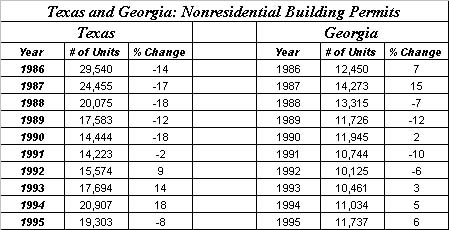 | |
It was important for this project/proposal that corporate taxation also be considered. It most certainly will influence where a new branch office will opened. The following is a very simple account of corporate taxation in the states of Texas and Georgia (U.S. Census Bureau, census.gov/govs/statetax/0244txstax.html). It is obvious that the state of Texas does not collect corporate taxes from commercial businesses; “it is unconstitutional for the state to put an income tax in place unless it is approved by a state wide vote. Texas is also a balanced budget state” (“Do Business in Austin”, www.austin-chamber.org). Internet search results show that “Georgia’s corporate income tax is a nongraduated percentage tax based on a corporation’s federal taxable net income. Corporations that own property, or do business, in Georgia are subject to corporate income tax. Further, the rate of taxation is six percent of a corporation’s taxable net income attributable to business done in Georgia. Further, certain corporations pay a net worth tax which is based on the net worth of a corporation and is levied in exchange for the privilege of doing business or exercising a corporate franchise in Georgia. The minimum is $10.00 for a net worth less than $10,001. The maximum is $5,000 for a net worth in excess of $22 million”, (Georgia Dept. of Revenue, www2.state.ga.us). | |
 | |
It should be noted that all of the above charts had to be recreated in Excel; the original most up-to-date statistical charts contained far more data than I needed for this project/proposal. The most simple and reliable method for obtaining accurate and up-to-date data was through the Internet. And, in most cases, I reviewed and extracted information that dated back ten years in order to show the trends. | |
|
Results After reviewing and comparing the statistical data obtained from the Internet, the obvious contrast (number crunching) determined where the next branch office should be established. I began by compiling a list of final totals, or outcomes, from all of the statistical charts I created from Internet sites. I had originally planned on doing the calculations in Excel on each chart, but since I was having trouble converting Excel charts to jpeg images, I decided to remove that problem by using a different format: simple line items. The change in format was advantageous since I was dealing with far less information.The following is the simple line-item statistical data comparisons between Texas and Georgia. | Top 50
cities in the
|
Population
and Change of Population (shift): 2002
|
|
Maps | |
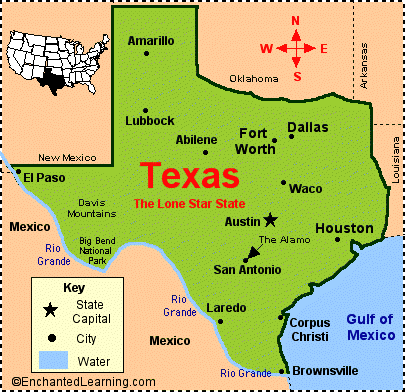 |
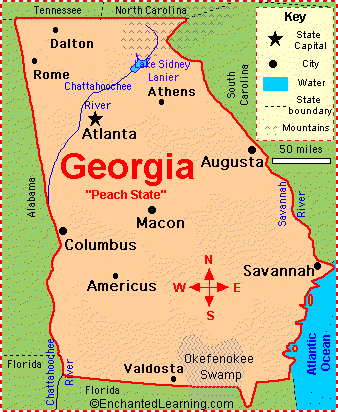 |
|
Analysis I had to abandon my original project topic, “The Top 20 Fastest-Growing Cities in the U.S.”; I did the same with the second topic, “The Top Five Fastest-Growing Cities in the U.S.” Both topics would require too much data and time. Yet, both topics would have given ABC, Incorporated the information they needed to investigate various regions in the U.S. for a new branch office. Still, needing to narrow the criteria of my topic, I re-interviewed the CFO of ABC, Inc. This was the smartest decision I made regarding the entire project. I asked the questions where and when? The CFO gave me the parameters I needed to get started: Texas or Georgia. I also spent considerable time locating current information on the building permit(s) topic, e.g., single-family building permits issued within the last ten years in the state of Texas and Georgia. I was fortunate to have located two reliable websites with the same information, but from different sources. I compared the data and found it nearly identical (the U.S. Census Bureau had the best data). As for nonresidential/commercial building permits, the U.S. Census Bureau stopped updating this information in 1995, and I was not able to locate any other data source on this topic. The greatest challenge of this project/proposal was organizing vast amounts of statistical information that I downloaded, or mostly printed, from the Internet. First, this data was far too extensive for practical purposes; second, I had to determine how much information I needed to show the trends within each state. Ten consecutive years, in most cases, seemed appropriate. Additionally, when dealing with large amounts of data it is nearly impossible to download, or print, partial data. I found that the easiest way of dealing with this was to print the entire chart then extract the information I needed to create my own charts in Excel. As mentioned before, I had difficulty with all of the charts. I started with extracting and condensing of statistical information from a number of Internet sites. I then created each statistical chart in Excel and copied them over to the Word version of this project. I then realized that the Excel charts had to be converted to jpeg format before copying into the html format. As I began to copy them over to their final destination, all of the charts were missing the left and top borders. I recreated them many times, but I continued to experience the same problems. I decided to leave them as they were and continue on with the project hoping to have time later to correct the problem. Further along in the project Word document, I changed from Excel charts to customized line items since I was dealing with far less information and to avoid additional problems. Locating population demographics was easy as there is a large amount of information on the Internet with the best site being the U.S. Census Bureau. There was limited information regarding corporation income tax for each state; however, I was able to locate it without too much difficulty. Finding compatible maps was another issue. I was able to find numerous, beautiful maps of Texas and Georgia on the Internet, but they were not compatible at all in appearance. Most of the maps had extraneous information; I eventually settled on two rather simple maps that resembled each other. Additionally, I considered creating a GIS map for Texas and Georgia, but it would not be advantageous here since I had very little to map out unless I expanded this project to include information about relocating ABC, Inc. employees (e.g., the location of schools, hospitals, outdoor activities, shopping areas, etc.). I will consider this in the future, but for practical purposes I left this data out. | |
|
Conclusions The secret to this project was organization and data management. Not enough informa-tion can certainly leave the reader with questions about the reliability of the presented data, and too much information can be a bore (not to mention the author drowning in a sea of paper and decisions). I also found that Internet data is not always downloadable; in most cases I had to print the data then extract the information I needed. While working on the Word document of this project, I realized that I could arrange the format to be useable as a template for future proposals—I did just that. ABC, Incorporated has mentioned that they intend on opening 8-10 offices within the next 2-5 years meaning potential work for me (a template certainly would streamline my job). I also learned how to use an HTML template that will be used on future projects. There were also limitations on the available data on the Internet. I was not able to use current up-to-date data in my statistical charts. However, the population and construction trends are still on the upswing in Texas while Georgia seems to be suffering from a somewhat depressed economy—population and construction lags far behind Texas. The final winner of the compiled data is Texas: the state is experiencing a boom in population and construction. While Georgia is attracting similar attention, it is on a much lesser scale. If ABC, Incorporated were to open an office in Georgia, rather than Texas, they would have to contend with all of the demographics of the surrounding states where they plan on doing business, greater expenses due to more traveling between states, varying building codes and permit requirements, and tax structures. ABC’s best bet is Texas: far less traveling to job sites, building codes and permits remain more constant, no corporate income taxes, and an office with personnel always present to deal with clients. Finally, the beauty of this project is that it can be expanded to include additional information such as the advantages of opening the new branch office in the state capitol, additional demographics and cost-of-living scale for possible relocation of employees, and GIS maps locating schools, hospitals, shopping areas, desirable housing, and outdoor attractions and activities. It would be a professional proposal for a company looking to expand its business in Texas, and it could very easily be used as a proposal-template for other regions within the United States. | |
|
References “The Ten Fastest-Growing Metropolitan Areas, 1990-2000”, April 13, 2004. http://www.InfoPlease.com/ipa/A0884487.html “Top 50 Cities in the U.S. by Population and Rank”, May 1, 2004. http://www.InfoPlease.com/ipa/A0763098.html “Texas Single-Family Building Permits”, 2002. The Real Estate Center at Texas A & M University. http://www.recenter.tamu.edu “Georgia Single-Family Building Permits”, 2002. The Real Estate Center at Texas A & M University. http://www.recenter.tamu.edu “Projections of the Total Population of States, 1995-2025”, Series A, April 30, 2004. http://www.census.gov/population/projections/state/stpjpop “State Government Tax Collections: 2002”, December 18, 2003. http://www.census.gov/govs/statetax/0244txstax.html “Georgia Department of Revenue”, 2003. http://www2.state.ga.US/departments/dor/ “DoBusiness in Greater Austin”, 2003. The Greater Austin Chamber of Commerce. http://www.austin-chamber.org/Do_Business/Relocate_to_Austin/Taxes/ “Texas and Georgia Quick Facts”, Quick Facts from the U.S. Census Bureau. http://quickfacts.census.gov/qfd/states/48000.html “Texas and Georgia State Maps”, www.EnchantedLearning.com | |